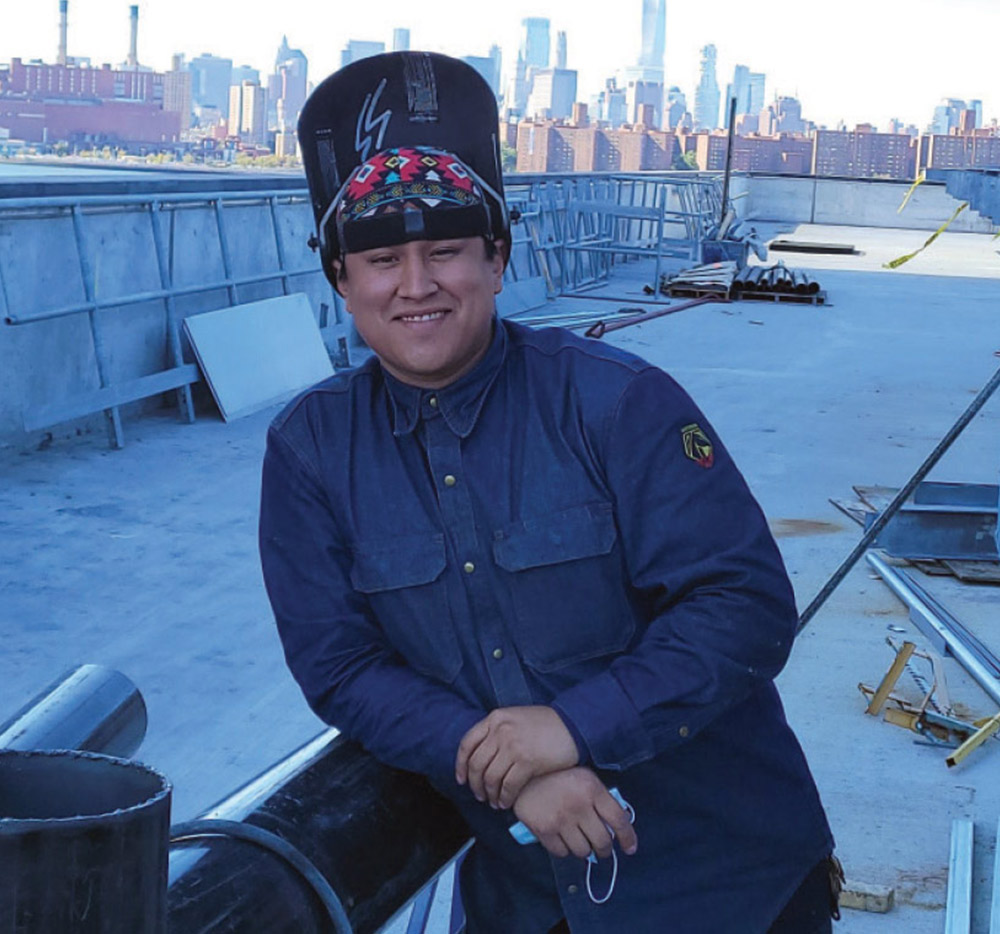VETERANS
VETERANS
 A free education while earning a paycheck and learning a trade is becoming more appealing than a life of student debt.
A free education while earning a paycheck and learning a trade is becoming more appealing than a life of student debt. 
Steps
fter serving for years in the military, the shift from active duty to civilian life can be daunting. Helpful programs exist during and after life in the military to help service members consider a career in the metal fabrication sector. FFJournal learns from those teaching, studying and organizing efforts to connect veterans with potential long-term career paths.
One of the biggest challenges facing the fabrication industry is finding qualified talent. “People coming out of the military make excellent candidates,” says Michael Harris, program administrator at the International Training Institute SMART workers program. “They’re used to working in a team environment, are dependable and take responsibility.”
Steps
 A free education while earning a paycheck and learning a trade is becoming more appealing than a life of student debt.
A free education while earning a paycheck and learning a trade is becoming more appealing than a life of student debt. 
fter serving for years in the military, the shift from active duty to civilian life can be daunting. Helpful programs exist during and after life in the military to help service members consider a career in the metal fabrication sector. FFJournal learns from those teaching, studying and organizing efforts to connect veterans with potential long-term career paths.
One of the biggest challenges facing the fabrication industry is finding qualified talent. “People coming out of the military make excellent candidates,” says Michael Harris, program administrator at the International Training Institute SMART workers program. “They’re used to working in a team environment, are dependable and take responsibility.”
Through his Arc Junkies Podcast, Valencia College Welding Program Manager Jason Becker learns directly from callers about industry problems as well as opportunities. He uses the podcast as a platform for people within the welding industry to communicate where jobs are as well as highlight industry issues. “There is a massive shortage of skilled trade workers today—not just welding,” Becker says. “Baby Boomers are retiring at a staggering rate, and we need the younger generation to fill those spots.”
“We need to highlight [skilled trades] current value, versatility and the importance to our national infrastructure,” echoes Sandy Kaider, manager, referral and training partners program at Hire Heroes USA. “Many of our veterans leave military service with limited resources to sustain themselves and their families, leaving little available to cover the cost of training or certifications while they look for a new career.
“This is where industry leaders can make an impact,” Kaider continues. “I believe more veterans would strongly consider a career in a skilled trade if the cost of training was reduced or at least more accessible.”
His interest in metalworking began in high school, where he was first introduced to welding through metalworking classes. When he signed up for the Marines, he requested to be assigned as a welder. “After taking a welding class in high school, I knew I wanted to work as a welder,” Becker says. He completed his basic training and went on to serve as a welder in the Marine Corps, welding “everything from howitzers to 7-ton troop carrying trucks, etc.”
After working as an aluminum ornamental handrail welder, he went on to fabricate structural steel. Eventually, he began work as a welding educator and is now welding program manager at Valencia College’s Advanced Manufacturing Training Center in Kissimmee, Florida. Becker also hosts the Arc Junkies Podcast, a show that connects the welding and metalworking community that he took over from founder Jimmy McKnight in May 2020.
At Valencia, Becker’s students range in age and background, but a large portion of them are veterans like himself. “We have many military veterans on staff and a well-engaged population in the central-Florida area,” Becker says. “Veterans use their G.I. bill to take courses and become ready for the workforce.”
Word of mouth has spread and students have transferred into his program from all around the state. “A common problem in our industry is that welding instructors either don’t care about the job they’re doing or they don’t give students any one-on-one time,” Becker says. “Instructors just don’t talk to their students.”

 Social media has opened up the conversation between welders in Missouri to Florida—all over the country.
Social media has opened up the conversation between welders in Missouri to Florida—all over the country. 
Arc Junkies Podcast

 Social media has opened up the conversation between welders in Missouri to Florida—all over the country.
Social media has opened up the conversation between welders in Missouri to Florida—all over the country. 
Arc Junkies Podcast
“Social media has opened up the conversation between welders in Missouri to Florida—all over the country,” he continues. “We meet up at trade shows and each year our networking reach gets bigger. Whether it’s well-established welders or those just getting into the trade, we’re actively connecting people with similar interests, and we help one another out.”
One of Becker’s students, Diego Navarro, didn’t initially consider welding after serving in the Marines. “I learned pretty quickly that the transition as a diesel mechanic in the Marines into the civilian world wasn’t what I wanted,” Navarro says. “But what I did know is that I wanted to continue working with my hands.”
A self-proclaimed gearhead and car junkie, Navarro wanted to learn more. “I had some minor experience welding and started looking around at instructional programs,” he recalls. “It blew my mind when I saw welding for the first time. I wanted to not just fix things but shape and morph and bend it into whatever shapes I wanted.”


After completing the welding program in December, Navarro is optimistic about his career path ahead. “I’m finding that there are many job options [including] positions as ironworkers, pipe fitters—so many things. My next step will be to learn more about thin-set, fine and precise aluminum welding.”
In December, Valencia College began working on a project called Operation Next, and is partnering with the American Welding Society for the curriculum used to train active duty and reservists how to weld so they can enter the workforce as soon as they leave the military. “Valencia is going above and beyond to build up the welding program here,” Becker says. “Our success rates, starting pay and word of mouth are helping us take advantage of these types of opportunities.”
When leaving the military, it can be difficult to transition back to civilian life. “You spend four or five years training to be an Airman, Marine, Soldier or Sailor but are only provided with transitioning training for a couple of days,” Becker says. “There’s room for additional work to be done for transitional periods.”


There are 150 apprenticeship programs throughout the U.S. It was integral that SMART have a teaching facility located near a military base with an active Armed Forces Career Skills Program (CSP) to help service men and women transition into civilian life.
Students in the SMART Heroes program attend classes four days a week at the ITI training facility for seven weeks. One day a week, instructors go onto the base to educate service members about ITI’s program.

In 2019, SMART Heroes opened a second facility in Colorado Springs, Colorado, near Ft. Carson. “Currently, we have an approximate 80 percent placement rate for those who graduate,” he says. “As we receive more applicants we’re finding that acceptance rates are more competitive. We run applicants through a screening process to find those students who would be a good fit for a career in sheet metal fabrication or HVAC sectors.”
“The UA VIP program also participates in on-base recruitment campaigns offered through the installation’s Army Morale, Welfare and Recreation office (MWR), which provides numerous avenues to advertise information about the program to prospective applicants,” says Hazard.
To date, the UA VIP program has trained over 2,400 transitioning service members nationwide. “Providing opportunities and careers to those who deserve it most has been the most rewarding experience for me personally,” says Hazard, himself a U.S. Navy veteran.

arcjunkies.com
Hire Heroes USA
hireheroesusa.org
Operation Next
opnextjobs.com
SMART Heroes
smart-heroes.org
UA VIP
uavip.org
Valencia College
net1.valenciacollege.edu/continuing-education-programs
Employers interested in hiring veterans or military spouses can also use Hire Heroes USA’s virtual career fairs or job board as resources to find the best candidate for their opportunities. “We conduct research about partners we believe would be a good match for our clients and reach out to them,” Kaider says.

 I believe more veterans would strongly consider a career in a skilled trade if the cost of training was reduced or at least more accessible.
I believe more veterans would strongly consider a career in a skilled trade if the cost of training was reduced or at least more accessible. 
Recently, Tulsa Welding School partnered with Hire Heroes USA, and efforts are ongoing to find other relationships as well as expand existing partnerships. “We are excited to expand our existing partnerships to include more metalworking and manufacturing opportunities for our clients,” Kaider says. “There are several apprenticeship programs that are currently in the pipeline and we are always on the lookout for more.”
Chief Operating Officer Ross Dickman says the skilled trades are a growing area of interest for veterans, “especially as they have tried to assess what types of careers would provide them with lifelong opportunities to have a fulfilling and challenging work environment,” he says. “Many of the military fields have a strong correlation to the metalworking trades.”
Kaider urges industry to consider hiring veterans or military spouses because “they know how to problem solve, adapt and get the job done.”





